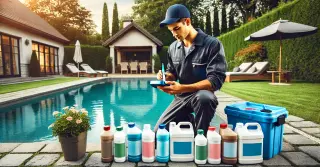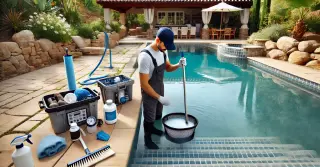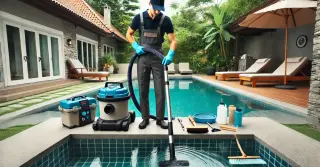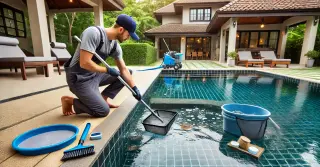Pool Chemical Balance Shoemakersville PA

Maintaining the proper chemical balance is essential for a safe and enjoyable swimming experience. Proper chemical levels prevent the growth of algae and bacteria, ensure clear water and protect pool surfaces and equipment.
- Maintaining Proper pH: The pH balance in your pool indicates its acidity or alkalinity. Optimal pH levels range from 7.2 to 7.6. Low pH levels result in acidic water, causing skin irritation and equipment corrosion. Alkaline water from high pH causes cloudiness and scaling. Regularly testing and adjusting the pH levels is vital for swimmer comfort and safety.
- Monitoring Chlorine Levels: Chlorine plays a crucial role in pool sanitation, as it kills bacteria, algae, and other harmful microorganisms. The proper chlorine level is between 1-3 ppm. Low chlorine levels cause unsanitary water, with bacteria and algae proliferating. Excessive chlorine leads to skin and eye irritation and create a strong chlorine smell. Regularly testing and adjusting chlorine levels ensures effective sanitation and swimmer comfort.
Optimal Alkalinity LevelsTotal alkalinity is another critical aspect of pool water chemistry. Alkalinity buffers pH levels, preventing drastic pH fluctuations. The ideal range for total alkalinity is between 80-120 ppm.
- Avoiding pH Fluctuations: Balanced alkalinity stabilizes pH levels, preventing rapid changes that can cause skin irritation and damage to pool surfaces. Low alkalinity causes pH levels to fluctuate, making balance maintenance challenging. Excessive alkalinity results in cloudy water and scaling. Frequent alkalinity testing and adjustments is vital for a balanced and stable pool.
- Managing Calcium Hardness: Calcium hardness indicates the calcium level in pool water. Proper calcium hardness levels range from 200 to 400 ppm. If calcium levels are too low, the water becomes corrosive, damaging pool surfaces and equipment. If calcium levels are too high, it can cause scaling on pool surfaces and cloud the water. Frequent calcium hardness testing and adjustments is crucial for safeguarding your pool and maintaining clear water.
Proper Chemical Use and StorageProper handling and storage of pool chemicals is crucial for safety and efficiency. Keep chemicals in a cool, dry location, away from direct sunlight, children, and pets. Always follow the manufacturer's instructions for correct dosing and application.
- Measuring and Mixing Chemicals: Precise measurement of pool chemicals is essential to maintain the proper balance. Using incorrect amounts can disturb chemical balance and water quality. Always use a clean, dry measuring tool and never combine chemicals directly. If needed, mix chemicals in water as per instructions.
- Understanding Chemical Reactions: Certain chemicals can react dangerously if mixed. Never mix chlorine with acid, for example. Understanding these interactions prevents accidents and ensures safe handling. Store chemicals separately and handle each with care to avoid harmful reactions.
Keeping your pool's chemical balance is essential for a safe, clean, and enjoyable swimming environment. By consistently testing and adjusting pH, chlorine, alkalinity, and calcium, you can keep your pool water in optimal condition.
Safe handling and storage of pool chemicals enhance the health and safety of your pool.




